Coffee
Coffee-to-Water Ratio + Charts for Every Method
Morning coffee is a ritual for many people, bringing a much-needed energy boost to start the day. While adding an extra scoop of grounds might seem like the solution to stronger coffee, the real secret lies in understanding the coffee-to-water ratio. Mastering this balance ensures your coffee is always flavorful, consistent, and tailored to your taste.
On those dreary, sluggish mornings, many night owls reach for an extra tablespoon of ground coffee, hoping for that much-needed energy boost. Sound familiar? Hate to break it to you, but this approach might not be the best way to enhance your coffee. Simply adding more coffee doesn’t necessarily make it stronger or better. The real secret lies in mastering the coffee-to-water ratio. Let’s explore this essential balance and brew a truly exceptional cup of coffee.
What Is the Coffee-to-Water Ratio?
A coffee-to-water ratio refers to the proportion of coffee grounds to water used in brewing. Each brewing method—whether drip, pour-over, or French press—has an ideal ratio. For instance, the drip coffee ratio is typically 1:16.67, ensuring a balanced flavor profile.
The “Golden Ratio” provides a general guideline of 1-2 tablespoons of coffee (approximately 10 grams) for every 6 ounces of water. Alternatively, this can be measured as 1:15—a common coffee water ratio used for most methods. However, it doesn’t apply to espresso, where a 1:2 ratio is applied. Espresso cups are traditionally much smaller than regular ones, so there is less water than usual.
The flexibility of this guideline allows you to experiment, adjusting the strength to match your preferences.Here you will find common proportions to brew your coffee – however, I recommend you experiment with different ratios to find your perfect balance.
Why Does Coffee-to-Water Ratio Matter?
When your coffee tastes too bitter or too weak, it’s often a sign that the brewing ratio was off. Achieving the correct coffee-to-water ratio ensures balanced extraction and brings out the best flavors in the beans.
For a stronger, bolder coffee, opt for a higher coffee-to-water proportion. Conversely, if you enjoy a milder and more balanced cup, use a slightly lower ratio. Brewing times also vary by method, with some requiring shorter durations (like espresso) and others needing longer steeping times (like cold brew). By experimenting with ratios and brewing times, you can tailor your coffee to your exact preference and ensure every cup is as satisfying as the last.
How Much Coffee Do You Need Per Cup?
There is a general rule called the “Golden Ratio,” where the ideal ratio is 1-2 tablespoons of ground coffee beans (~10g) for 6 ounces of water. Or a 1:15 ratio, which means 1 part coffee to 15 parts water. In other words, 1 gram of coffee for every 15 grams (or milliliters, it’s the same thing) of water. This translates to approximately 1-2 tablespoons of coffee per cup, depending on the size and your taste preferences.
Coffee-to-Water Ratio for Different Brewing Methods
Understanding the ideal coffee-to-water ratio for various brewing methods is essential for creating the perfect cup. Below are detailed ratios to ensure your coffee is consistently flavorful and balanced, answering the question, how much coffee grounds per cup or how much coffee per cup.
Automatic Drip Coffee Ratio – 1:16.67
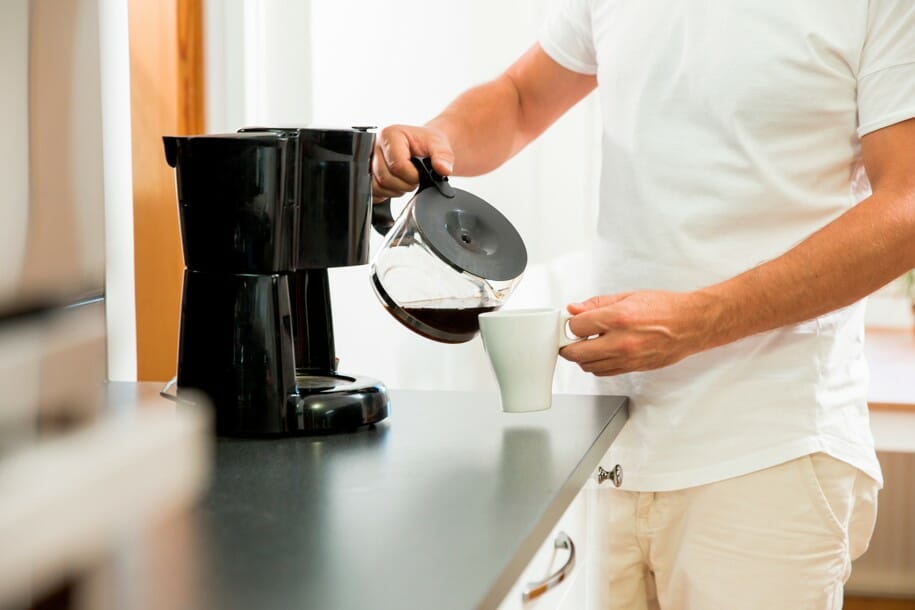 Drip coffee is probably one of the most traditional brew methods out there. Combined with fresh coffee grounds, your cup of coffee will taste fine and flavorful. The ideal ratio for fine drip coffee is 1:16.67, or 60 grams of coffee to 1000 grams of water.
Drip coffee is probably one of the most traditional brew methods out there. Combined with fresh coffee grounds, your cup of coffee will taste fine and flavorful. The ideal ratio for fine drip coffee is 1:16.67, or 60 grams of coffee to 1000 grams of water.
Pour-Overs Coffee-to-Water Ratio – 1:16.67
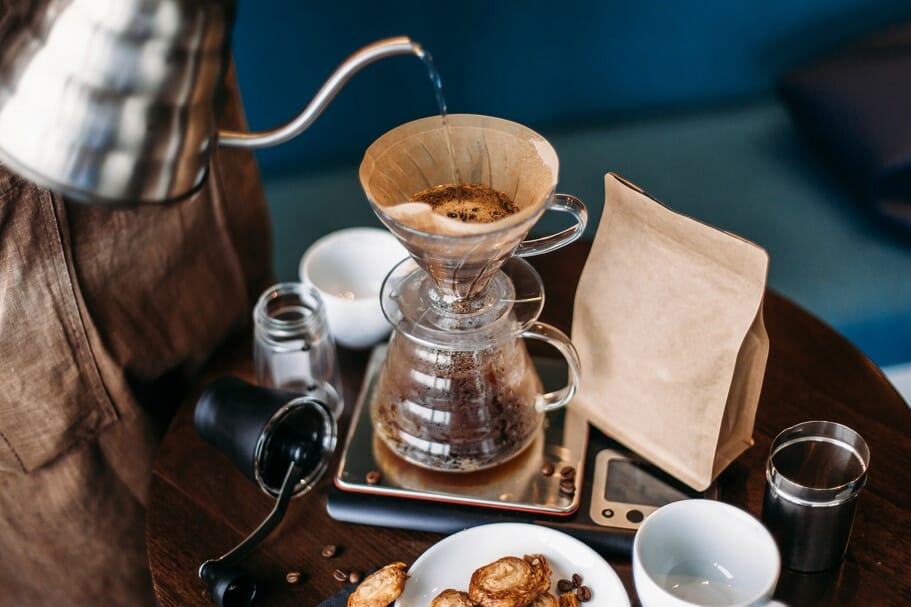 Pour-over coffee is brewed similarly to drip coffee, with the only difference being that in a previous method, you have an auto-drip coffee maker.
Pour-over coffee is brewed similarly to drip coffee, with the only difference being that in a previous method, you have an auto-drip coffee maker.
To brew a cup of pour-over coffee, you need to heat up water and slowly pour it over ground coffee. The ratio of 1:16.67 will not make your coffee taste bitter but will give it a strong-enough and aromatic flavor.
For a mouthful cup of pour-over coffee, you can use 12 grams of coffee and 200 grams of water.
Aeropress Coffee-to-Water Ratio – 1:15
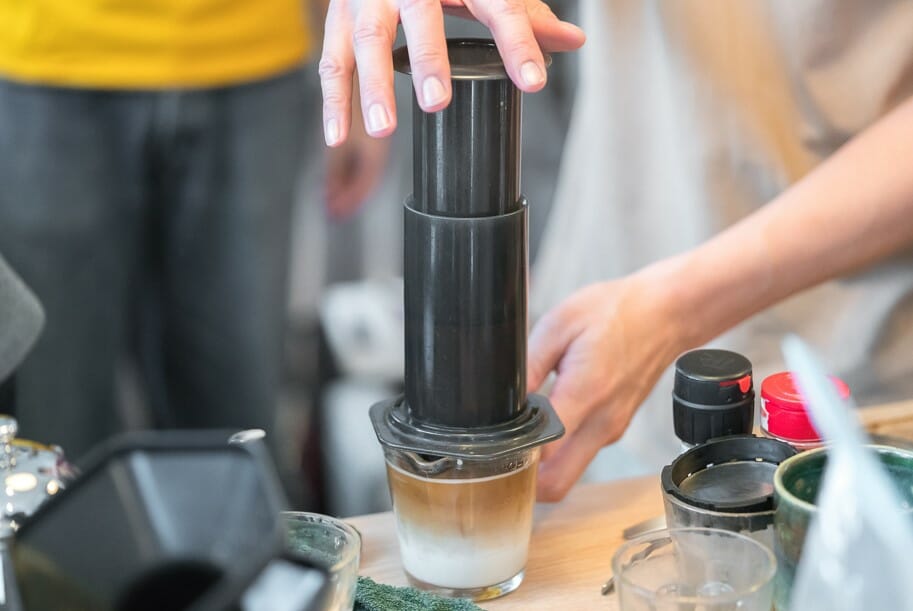 For this method, I would recommend using an inverted technique instead of a traditional one. Basically, you add coffee to your Aeropress and fill it with the required amount of water, and then flip it upside down with your cup located right under it.
For this method, I would recommend using an inverted technique instead of a traditional one. Basically, you add coffee to your Aeropress and fill it with the required amount of water, and then flip it upside down with your cup located right under it.
After you add coffee and water to your Aeropress, you also place a paper filter and only then do you invert and press the plunger down. This style of brewing is somewhat similar to the French press but reversed. So, coffee brews and drips into your cup.
The ratio is 1:15, and it will brew you a tasty cup of coffee, not bitter and not watery but just right.
French Press Coffee Ratio – 1:15
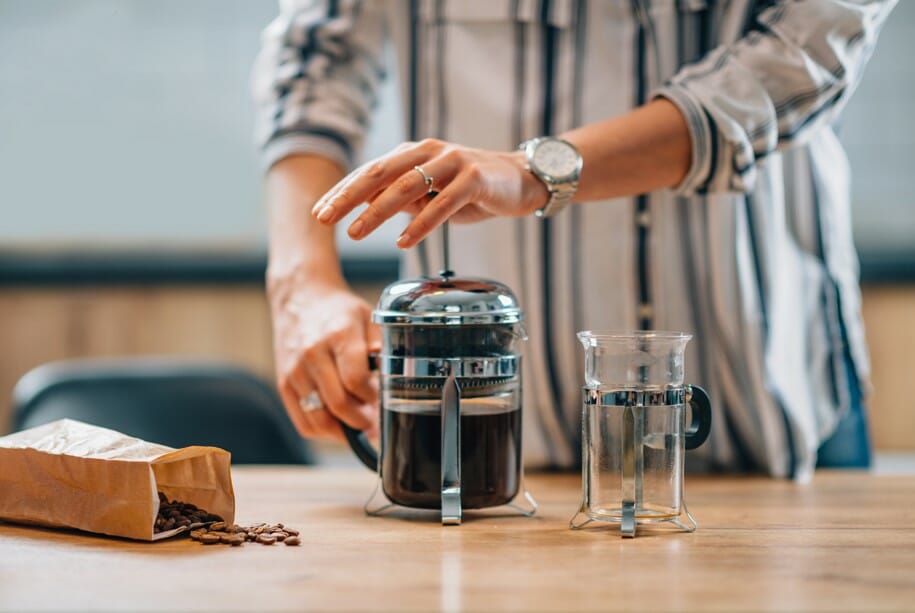 Coffee makers are in love with classic French press coffee. This brew ratio of 1:12 or sometimes even 1:15 will be just enough for a few cups of coffee.
Coffee makers are in love with classic French press coffee. This brew ratio of 1:12 or sometimes even 1:15 will be just enough for a few cups of coffee.
Grab your French press from the kitchen cabinet, place coarsely ground coffee in the bottom, and pour hot water over it. Give it a quick stir and let it steep for a few minutes.
Once you press the plunger down (do it slowly), the robust flavor of the coffee will infiltrate your brew. To get the mouthful of full-bodied flavor, let your coffee steep for at least 4-5 minutes.
The ideal ratio here is 1:15, or about 30 grams of coffee to 450 grams of water.
Cold Brew Coffee-to-Water Ratio – 1:8
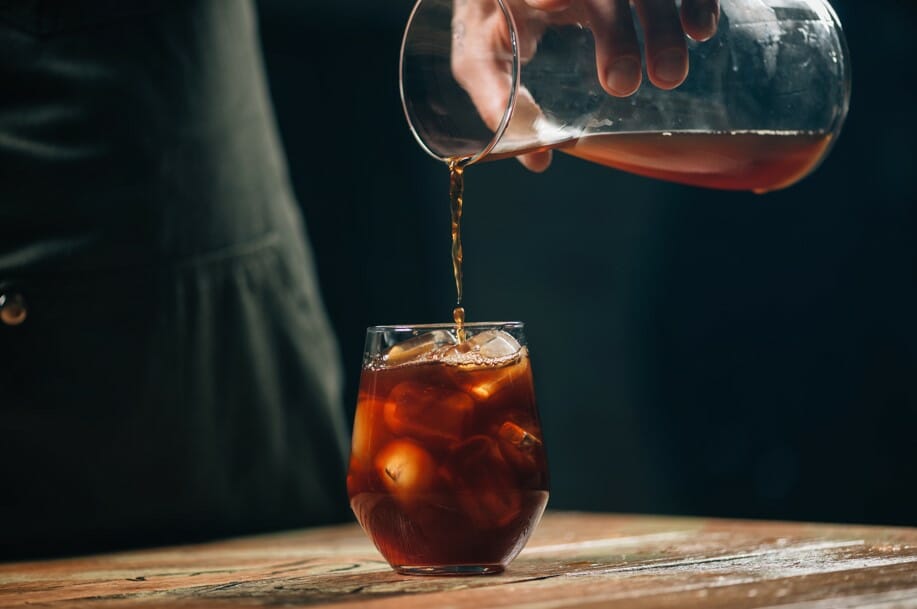 For this brewing method, hot water is replaced with cold or room temperature. Unlike other methods, this one also takes an extended period of time to properly brew – 12-24 hours. The concentrate is later diluted with water or milk to make a cold cup of coffee.
For this brewing method, hot water is replaced with cold or room temperature. Unlike other methods, this one also takes an extended period of time to properly brew – 12-24 hours. The concentrate is later diluted with water or milk to make a cold cup of coffee.
A common ratio is around 1:8, or for example, 25 grams of coffee to 200 grams of water. This is the go-to method for those looking to make iced coffee, as the concentrate can be poured over ice and customized with syrups or cream for a refreshing beverage.
Note: The coffee-to-water ratio for cold brew coffee is generally higher than the ratio used for hot brew methods, such as drip coffee or French press. This is because the extended brewing time of cold brew coffee allows more of the coffee’s flavors and oils to be extracted from the beans, so a higher ratio of coffee to water is needed to achieve the desired strength and flavor.
Chemex Coffee-to-Water Ratio – 1:17

The recommended ratio by Chemex is 1 tablespoon for every 5 ounces of water. However, it brews quite a strong coffee and tastes a bit bitter for some. The advised ratio is 1:15.
If you prefer a milder taste, increase the water ratio up to 17, meaning experiment with which proportion tastes the best for you, from 1:15 to 1:17. Start with 20 grams of coffee and 300 grams of water. Increase the water ratio if the coffee tastes a bit stronger than you like it.
Moka Pot Coffee-to-Water Ratio – 1:12
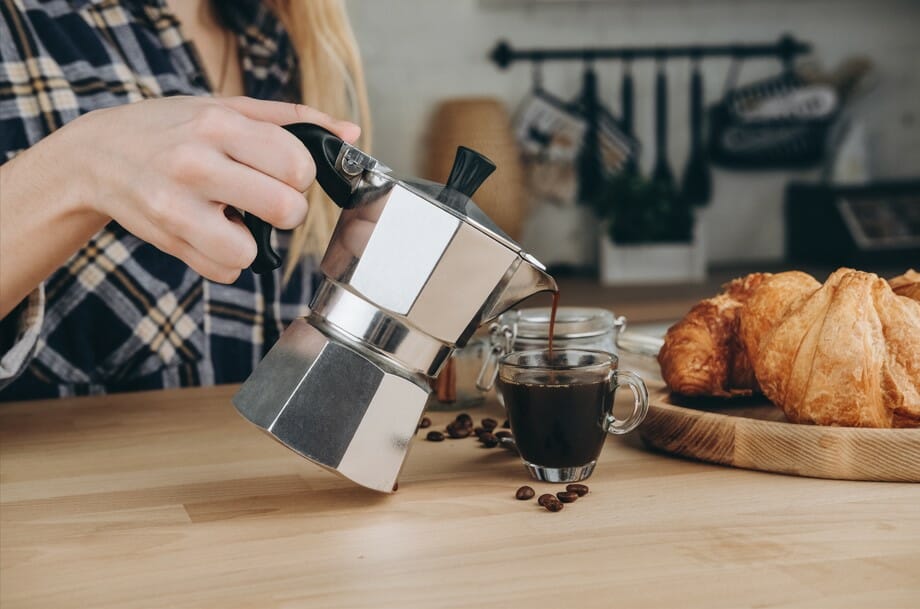
13 grams of coffee and about 170 grams of water will result in 2 small cups of perfect coffee. The ratio is 1:12, but I’ve heard people like a brew ratio of 1:10, where you measure 20 grams of coffee and 200 grams of water.
V60 Coffee-to-Water Ratio – 1:16
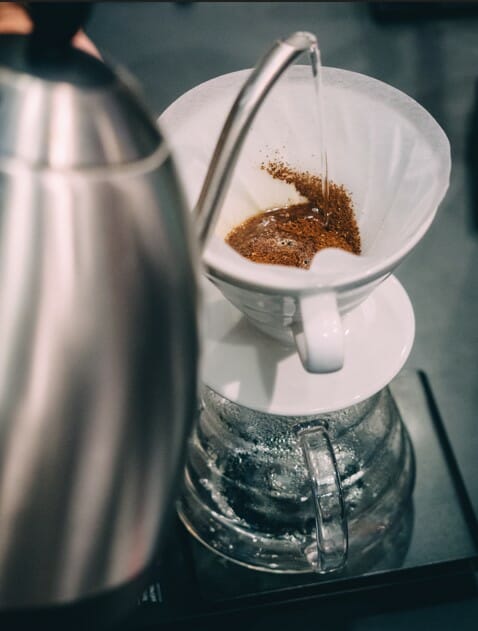
V60 coffee-brewing method is very similar to Chemex – both use a pour-over technique and let the coffee drip into your cup. The only significant difference is (except for the coffee makers) the filter used. The Chemex coffee maker uses a thick paper filter, allowing it to brew clear, sediment-free coffee. Although V60 has a thinner paper filter, it doesn’t mean you get bad coffee – on the contrary, the brew is clear as well.
In fact, some people started using V60 paper filters on the Chemex coffee makers – or vice versa – because the Chemex filters may sometimes be hard to find in local stores.
The recommended ratio for V60 is 1:16, which translates into 15 grams of coffee and 240 grams of water for one cup. Double the measurements to brew two cups.
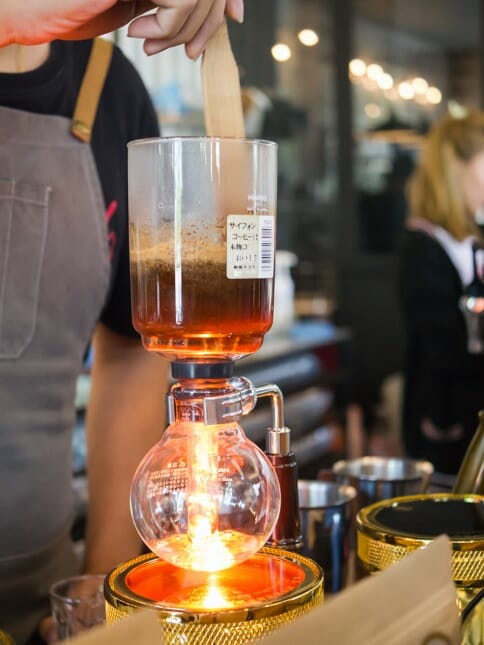
Siphon Coffee-to-Water Ratio – 1:15
Siphons must be one of the most unique-looking coffee makers. Bring one home and feel like a witch brewing a potion.
The setup is fairly easy, although the coffee makers may look puzzling at first. First, you need to place a filter into the funnel or the upper part of the coffee maker. Next, you need to heat your water and pour it into the lower part now. Once it’s done, attach the upper chamber to the lower one.
If you use an electric siphon, make sure the funnel sits steady and is far inside the lower chamber. On the other hand, if you have a non-electric siphon, you should place the funnel closely on top of the lower chamber and let it sit at an angle.
Next, to start brewing your magical coffee, it needs a heat source. Electric coffee makers work with a single click of a button, but you need to light up a candle burner located right under traditional siphons.
As the water heats up inside the lower chamber and starts building up in the upper chamber, it is time to add your measured coffee to the upper funnel. Give your coffee a stir and let it brew for a few minutes.
The ideal coffee-to-water ratio is 1:15 – a very common proportion for most of the methods, actually. For a siphon, you can grind 27 grams of coffee and preheat 400 grams of water.
Espresso Coffee-to-Water Ratio – 1:2

The optimal coffee-to-water ratio is undoubtedly 1:2. However, it doesn’t mean you have to stick to this proportion. Don’t be afraid to try the equal ratio of 1:1, or else called ristretto, a shot of bitter coffee to give a lasting boost of energy before a long journey or a hard-working day.
If you despise bitterness, why not increase the water ratio and try a 1:4 proportion, or else called lungo, a slightly bigger espresso cup?
The Role of Measurement Precision
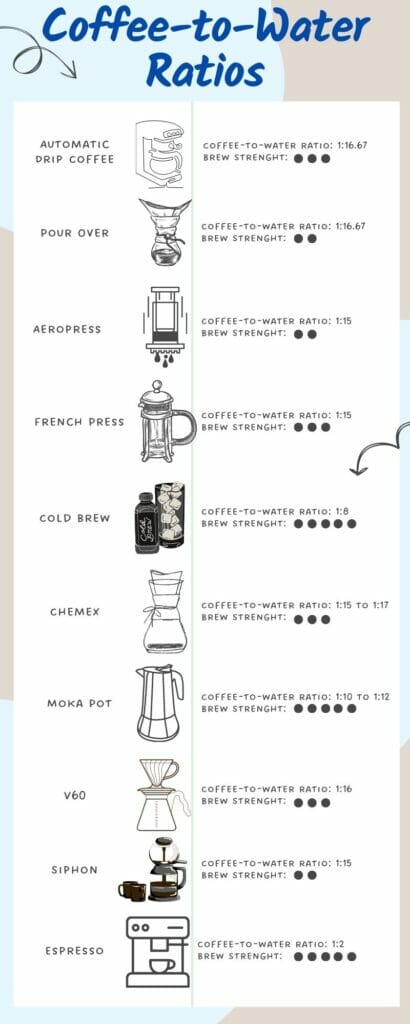
Measurement precision is key to brewing a consistently delicious cup of coffee. Using tools like a digital scale ensures that the coffee-to-water ratio remains accurate, avoiding over- or under-extraction. For instance, knowing how much ground coffee per cup you’re using helps maintain the ideal balance of strength and flavor.
Accurate measurements are particularly important for methods like the chemex coffee to water ratio or v60 coffee to water ratio, where even slight variations in coffee grounds to water ratio can impact the final taste. A precise drip coffee ratio of 1:16.67, for example, ensures a balanced cup every time. Precision also comes in handy when scaling recipes for larger quantities
Impact of Grind Size on Extraction
The size of your coffee grounds plays a crucial role in how effectively the water extracts flavors from the beans. A fine grind, as used in the espresso coffee to water ratio, increases surface area, leading to faster extraction. Conversely, a coarser grind is better suited for methods like the french press coffee to water ratio or cold brew coffee to water ratio, where longer steeping times allow for full flavor development. Matching grind size to your brewing method also ensures the perfect coffee ratio is achieved.
Water Quality and Temperature
Water quality and temperature play a crucial role in brewing a flavorful cup of coffee. Filtered water ensures that impurities don’t interfere with the coffee’s natural taste. The temperature range of 195°F to 205°F is ideal, as it maximizes extraction without causing over- or under-extraction.
Clean water enhances the flavor profile of any brewing method, allowing the natural notes of the beans to shine. High water quality benefits methods like pour-over and drip coffee, where precision is critical, and ensures consistency in techniques such as espresso or cold brew. Temperature precision also prevents bitterness from overly hot water or weak flavors from cooler temperatures. By focusing on these factors, you can achieve a perfectly balanced cup tailored to your preferences.
Customizing Ratios to Personal Taste
Brewing coffee is as much an art as it is a science. While standard ratios like the coffee golden ratio provide a reliable foundation, personal taste preferences can dictate adjustments. If you enjoy a strong, bold flavor, try reducing the water slightly for a richer cup. For those who prefer lighter, milder brews, increasing the water can soften the intensity.
Experimentation is key when customizing ratios. You might find that adjusting the drip coffee to water ratio or the french press coffee to water ratio by even a small margin can dramatically change the flavor profile. Keep a journal of your experiments to find your ideal balance, and don’t hesitate to tweak recipes for methods like the chemex coffee to water ratio or cold brew coffee to water ratio until you achieve your perfect cup.
Common Mistakes and How to Avoid Them
Even with the best intentions, a few common mistakes can compromise your coffee. One frequent issue is imprecise measurements, which can disrupt the balance of the coffee-to-water ratio. Always use a scale to ensure accuracy, especially when brewing larger quantities.
Another mistake is ignoring the importance of grind size. Using a fine grind for methods like the french press coffee to water ratio can result in over-extraction, while a coarse grind in espresso may lead to weak, under-extracted coffee. Match your grind size to your brewing method for optimal results.
Finally, avoid using water that is too hot or too cool. Water outside the ideal temperature range can either burn the coffee, making it bitter, or fail to extract flavors fully, leaving it bland. With careful attention to these details, you can sidestep common pitfalls and enjoy consistently great coffee.
Conclusion
Coffee is a morning ritual, a revitalizing drink, and is just better than ta in so many ways. It does have its pros and cons. The cons are the amount of time and effort you spend preparing a cup of coffee. The pros are the amount of time and effort you put into making a mouthful cup of aromatic coffee.
Coffee devotees understand the best. Brewing the best coffee requires practice and freshly roasted and ground coffee beans. It simply doesn’t taste the same with old beans – trust me.
All in all, you can follow the Golden Ratio for most of the brew methods but remember to experiment with the proportion to find your personal ratio.
FAQs
How many scoops of coffee do I need for 1 cup?
A tablespoon of coffee equals around 10 grams, which is a bit less than you need for a full cup of coffee. The recommended amount is about 10-15 grams (1 ½ to 2 tablespoons) per 6 ounces of water.
Following the standard coffee-to-water ratio of 1:15, you can use 12 grams of coffee to 180 grams of water.
How to calculate ratios?
The quickest way to calculate ratios is to use a free coffee-to-water ratio calculator.
Or you can do the following:
Let’s say you have 30 grams of coffee and a 1:16 ratio.
You need to multiply the amount of coffee beans by chosen ratio.
30 x 16 = 480
You need 480 grams of water to brew coffee with 30 grams of ground coffee beans.
How much ground coffee do I use for 2 cups of water?
As the Golden Ratio states, you need to follow the 1:15 ratio. You will need approximately 20 grams of ground coffee and 300 grams of water to make 2 cups of coffee.
How much ground coffee do I use for 4 cups of water?
For measuring the proportion, we will follow the Golden Ratio (1:15). For one cup, you need about 10 grams of coffee, so it makes more or less 40 grams for 4 cups. Multiplied by 15, you need 600 grams of water.
How much ground coffee do I use for 6 cups of water?
For 6 cups of coffee, you need 60 grams of freshly roasted coffee and 900 grams of water.
How much ground coffee do I use for 8 cups of water?
For 8 cups of coffee, you will need to grind approximately 80 grams of coffee and 1200 grams of water.
How much ground coffee do I use for 12 cups of water?
I am not sure if there is a coffee maker that is able to brew 12 cups of coffee at once, but for those curious minds, the answer is 120 grams of coffee and 1800 grams of water.

Barry Konkin is the founder of HotShot Coffee Sleeves. With over 30 years experience in commercial offset printing, Barry utilized his diverse printing background and creativity in developing new coffee sleeve designs that were granted Patents in both the USA and Canada. Barry’s goal is to assist businesses with brand promotion through the use of high quality custom printed cup sleeves. With an understanding of your marketing and operational objectives, Barry can recommend the ideal coffee sleeve solution for you.


